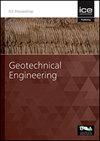关于静态液化触发评估的一些不确定因素
IF 2
4区 工程技术
Q3 ENGINEERING, GEOLOGICAL
Proceedings of the Institution of Civil Engineers-Geotechnical Engineering
Pub Date : 2022-01-05
DOI:10.1680/jgeen.21.00054
引用次数: 4
摘要
静态液化已被确定为最近几起尾矿储存设施(TSF)故障的原因。部分基于所进行的研究,在静态液化触发分析方面取得了重大进展。这包括在应力变形框架中应用基于临界状态的模型,以确定原位条件是否接近可能发生触发的水平。然而,一些重要的不确定性仍然存在。目前的工作研究了这些不确定性中的三个及其对静态液化触发和边坡破坏识别的影响(包括独立的和联合的):地静应力比K0,中间主应力比和垂直方向的主应力角。通过对理想TSF的一系列数值分析来检验这些不确定性。利用不同的K0值考察了它们对触发的影响,并对中间主应力比和垂直方向主应力角对失稳的潜在影响采取了不同的方法。这项工作表明,目前在这些领域的知识状况是这样的,在试图准确确定特定斜坡何时可能经历静态液化触发时,显着的不确定性似乎是不可避免的。概述了可能有助于减少这种不确定性的实验和原位测试程序。本文章由计算机程序翻译,如有差异,请以英文原文为准。
On some uncertainties related to static liquefaction triggering assessments
Static liquefaction has been identified as the cause of several recent tailings storage facility (TSF) failures. Partially based on the investigations carried out, significant advances on the analysis of static liquefaction triggering have been made. This includes application of critical state-based models in a stress-deformation framework to identify if in situ conditions are approaching a level where triggering could occur. However, several important uncertainties remain. The current work investigates three of these uncertainties and their effect (both independently, and in conjunction) on the identification of static liquefaction triggering and slope failure: geostatic stress ratio K0, intermediate principal stress ratio, and principal stress angle from vertical. These uncertainties are examined through a series of numerical analyses of an idealised TSF. Various values of K0 are used to examine their effect on triggering, while different approaches to the potential effect of intermediate principal stress ratio and principal stress angle from vertical on instability are taken. This work shows that current state of knowledge in these areas is such that significant uncertainty seems unavoidable in attempting to identify exactly when a particular slope may undergo static liquefaction triggering. Experimental and in situ test programs that may be useful in reducing this uncertainty are outlined.
求助全文
通过发布文献求助,成功后即可免费获取论文全文。
去求助
来源期刊
CiteScore
4.40
自引率
4.50%
发文量
68
审稿时长
3 months
期刊介绍:
Geotechnical Engineering provides a forum for the publication of high quality, topical and relevant technical papers covering all aspects of geotechnical research, design, construction and performance. The journal aims to be of interest to those civil, structural or geotechnical engineering practitioners wishing to develop a greater understanding of the influence of geotechnics on the built environment.

 求助内容:
求助内容: 应助结果提醒方式:
应助结果提醒方式:


